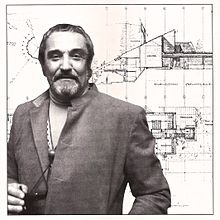Roger D'Astous
| Roger D'Astous | |
|---|---|

Roger D'Astous (1991)
|
|
| Born |
March 3, 1926 Montreal, Canada |
| Died | April 5, 1998 (aged 72) |
| Nationality | Canadian |
| Alma mater | École des Beaux-Arts de Montréal (1946-52), Frank Lloyd Wright, Taliesin East and West (1953) |
| Occupation | Architect |
| Buildings |
|
Roger D'Astous, architect (born in Montreal, Quebec 3 March 1926; died in Montreal, Quebec 5 April 1998), second child of a family of four children. His father (René D'Astous) worked at the local newspaper and his mother (Corine Basilières) gave him his artistic inspirations.
D'Astous began his schooling with the Sisters of Providence school, before enrolling in science courses at Mont-Saint-Louis College in Montreal in 1940. He began six years later, an architect degree at the École of fine arts in Montreal. After graduating in 1952, he joined the Taliesin Fellowship, where he completed a one-year internship (from August 1952 to July 1953) under the direction of American architect Frank Lloyd Wright in Wisconsin and Arizona, thus becoming the first Quebecer architect to become an apprentice to FLW. Although his architecture was always inspired by Wright's principles, D'Astous gradually came to take on great originality of form.
Roger D'Astous opened his firm in Montreal in 1953. His first two works were a home (Laurion house, Laval-sur-le-Lac, 1954–55) and a church (Notre-Dame-du-Bel-Amour, Cartierville, 1955–56), two building types for which he would become renowned and which brought him immediate success. He was twice as prolific between 1955 and 1967 as during the other 30 years of his career. His 12 churches, characterized by a quest for mystery and primitivism. He built a number of luxury homes primarily in the Montreal area and in eastern Ontario, where he also designed a number of smaller commercial buildings. Riding the wave of energy that swept the Montreal construction industry in the 1960s, he built the Christian Pavilion at EXPO 67 (1965–67), the Beaubien metro station (1962–66) and a major hotel, the Chateau Champlain (1963–67). During the same period, he worked with Jean-Paul Pothier, who remained his partner from 1965 until Pothier's death in 1968.
In 1974, D'Astous began working with Luc Durand, who remained his associate through to the end of his career. Their first commission was the Olympic Village (1974–76). The year 1984 marked the dawn of a renaissance for D'Astous. His projects remained few and consisted almost entirely of residences; however, the period was characterized by a new creative effervescence that lasted until his career's end. He had dreamt for many years of designing architecture reflecting Nordic and Canadian influences. He placed great emphasis on interior treatments, which he thought should evoke a feeling of protection in the same manner as exteriors. His homes in this style featured large slanted panels with roofs often sloping downward as far as ground level. These innovative shapes, which he had previously incorporated into the Lussier house (Saint-Bruno, 1963–65), were featured in all of his later residential designs as well as in the building housing the offices of the Forest Engineering Research Institute of Canada (Pointe-Claire, 1993–94).
...
Wikipedia
